Write Us
We are just a call away
[ LET’S TALK AI ]
X
Discover AI-
Powered Solutions
Get ready to explore cutting-edge AI technologies that can transform your workflow!

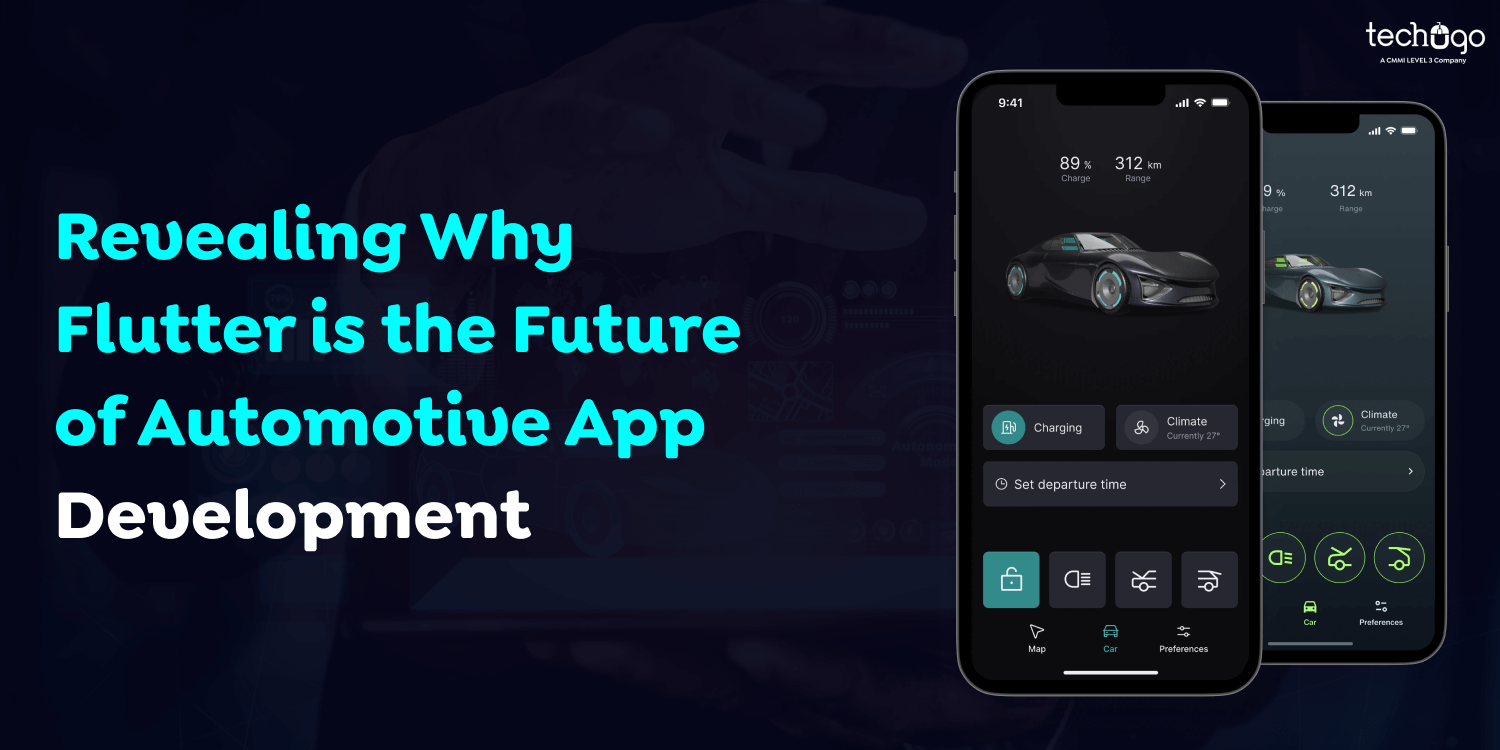
To ensure longevity, creating a cross-platform car application requires continuous brainstorming, innovative methods, usability, and niche and technology expertise.
Businesses must develop cross-platform apps to ensure they align with the latest market trends. Let’s discuss the technical aspects of creating an app across platforms. As we look at the broad scope, you will also understand how a specific programming language is compatible with a particular industry.
In light of this, we talked with you about why the Flutter framework is ideal for use in automotive manufacturing. To justify the previous assertion and the primary point of this post, should we explore the idea of developing apps using Flutter? Let’s get cracking.
Flutter is an open-source mobile app development framework developed by Google. It lets developers build cross-platform Android,iOS, desktop, and web apps using the same codebase.
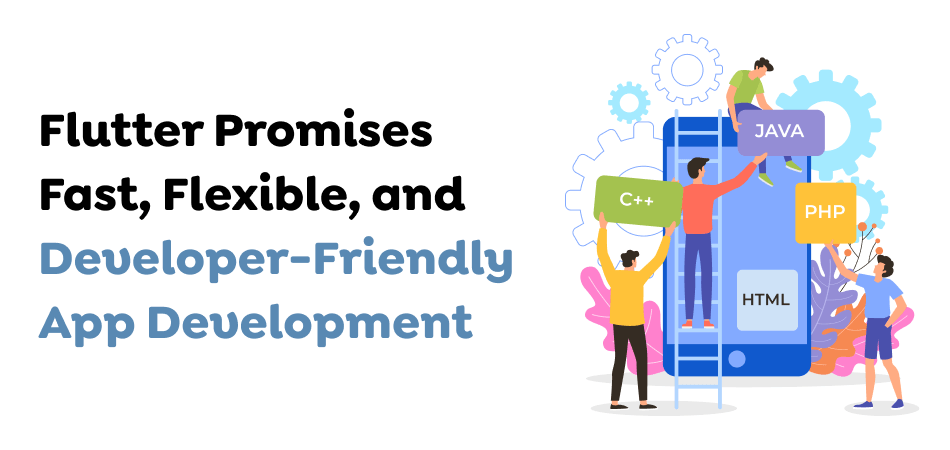
Flutter is based on Dart, an open-source programming language created by Google for building UI design. The Dart language is translated into machine code, ensuring speedy performance and romance.
The Flutter engine doesn’t depend on rendering tools specific to a particular platform; instead, it uses open-source graphic libraries, such as Skia, to render the UI. This gives users identical visuals regardless of what platform they’re using. This engine for customizing graphics delivers rapid, uniform, and flexible rendering.
Alongside improved performance and platform abstraction, Flutter is very developer-accommodating. For instance, Flutter allows hot reload, allowing developers to check changes to their code without restarting the application and losing its state. If hot reload triggers following a code change, the relevant libraries are rebuilt and loaded into the running Dart VM, which triggers hot re-layout with no re-execution. This enables developers to construct and modify UIs quickly.
Flutter comes with various tools to assist in examining widgets and resolving issues with UI layouts. Some top IDEs, like Visual Studio Code and IntelliJ (Android Studio), offer excellent integration with Flutter.
Also Read : Why Is Flutter The Ultimate Choice For Your Mobile App Startup?
Here’s a brief review of the advantages of developing apps using Flutter and the drawbacks you need to be aware of to ensure that Flutter works effectively.
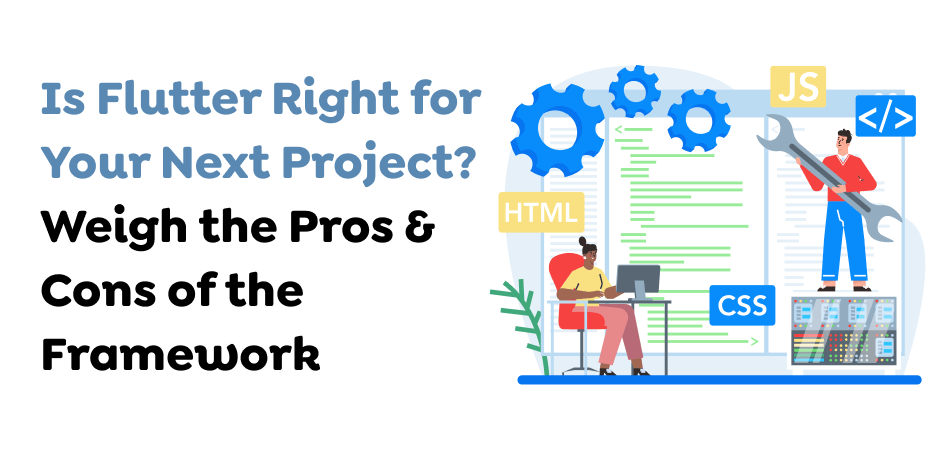
Single Codebase Compatible with all Platforms: There’s no need to build separate codebases to work with iOS and Android devices. Flutter lets developers create and use one codebase across multiple desktop, web, and mobile platforms. This allows for faster app development. This automatically turns fruitful as it saves time and money.
Shorter Development Time: Flutter’s app development requirements are significantly less, resulting in no additional maintenance fees. Flutter also lets you develop apps of larger sizes that incorporate distinctive features.
Faster Time-to-Market: The Framework for the development of Flutter is much more flexible than the other development frameworks. Its rapid time-to-market speed is among its significant benefits. It’s difficult to determine the likelihood that iOS and Android versions can deliver an item on time. This is where Flutter can help because it permits using both platforms.
Native-like Performance: This is one of Flutter’s most notable advantages. Flutter is compatible with the Skia graphics engine, allowing quick and optimized development. It is also indistinguishable from native apps since it doesn’t depend on interpreters or intermediary code representations.
Strong Community: According to statistics, Flutter was ranked as one of the more well-known frameworks and is a top option for developers across the globe. Over 40 percent of software developers have opted for Flutter in the past three years. The following graph illustrates the increasing popularity of Flutter as compared to other cross-platform application tools.
Own Rendering Engine: A significant issue with cross-platform rendering engines is that they’re extremely alike on iOS and Android. Flutter is the most suitable choice since it consists of applications with various widgets that work on each operating system.
Hot Reload Function: The capability to hot reload is among the primary advantages of using Flutter. This allows for efficient cross-platform development and will complement Flutter’s capabilities. This feature speeds up app development.
Safety of Flutter: Null-safety can be used at the syntax level. Flutter’s UI software is single-threaded, and computation threads are run in isolated sandboxes, meaning there are no shared or unsafe resources.
Dart: The developers chose Flutter because of the Dart programming language, Flutter, which is built on. Flutter has several specific features that help it stand above other languages:
Dart converts to highly optimized JavaScript on web-based platforms. The next step is WebAssembly for Web, which will offer more efficient execution/animation speeds compared to other platforms. These are just a few advantages that help Dart count as a benefit of using Flutter for development purposes.
Fantastic Documentation and Support for Community Members: Flutter benefits from extensive documentation and a lively community. Developers can easily access guides, tutorials, and assistance, making it easy to master and solve any issues they face.
Increasing Popularity: The Flutter platform is gaining popularity in the industry. It has seen significant growth and is used by prominent companies like Google, Alibaba, and Tencent. The growing popularity of Flutter ensures continuous support and regular updates from Google and members of the Flutter community.
Material Design and Cupertino Widgets: Flutter supports each of the Material Design (Android) and Cupertino (iOS) sets of widgets out of the box. This ensures that the UI is a native experience on both platforms, providing the same and familiar user experience.
Every tool is not perfect, and Flutter could be better by now. Flutter has drawbacks because it’s still a newly developed tool for specific applications. It is important to remember that it was only created a few years ago, so the community is still testing it to determine its limits and identify compatibility issues on different platforms.
Because it’s designed to work with various platforms, leveraging their unique features can make it challenging and time-consuming to make it work on all platforms; however, here at Techugo, we believe that the tool will eventually get there.
Heavy and Large-Sized Apps: The only loophole that must be addressed is the magnitude of the apps in development. Software developers who use this toolkit might have difficulty working with massive files. This may lead them to select a more accessible alternative.
Low Popularity of Dart is not a Surprise: Dart is a highly reliable programming language because it’s fast. It’s also true that developers are beginning to make Dart an alternative. But Dart can still not compete with popular programming languages like Java, Kotlin, etc.
Issues with iOS: The Flutter framework is compatible with Android and iOS platforms. It is worth noting that Google developed Flutter, which benefits Android apps. It’s not considered a significant issue, but it’s something to consider if there are issues soon.
Small Number of Third-party Libraries: Flutter has a relatively small number of libraries, which means it cannot be compared with the native programming languages. Developers must work harder to create as many libraries as they can.
It is a brand-new toolkit still adjusting to new developments and advancements. However, we hope to have given an understanding of the reasons Flutter is an ideal choice. Flutter is a speedy and affordable alternative to native application development.
Also Read : The True Cost to Develop a Flutter App: Unlocking Growth and Success
Due to Flutter’s capacity to design visually appealing UI, cross-platform support, and user-friendliness, it’s not surprising that it found its way into developing automotive software. Flutter is a popular choice to complement mobile applications and in-car infotainment systems.
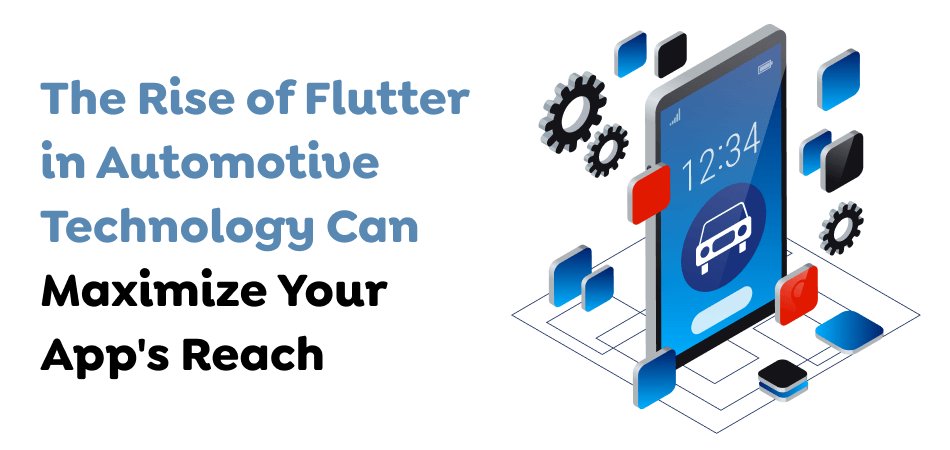
The majority of car manufacturers provide their mobile apps for their customers. These apps offer a variety of car-related functions, from basic features like access to the user’s manual and maintenance reminders to scheduling services to more sophisticated features like remote door unlock or unlock, engine start, and more.
The most common approach is native development of iOS and Android, in which a Flutter app development company must employ two teams to build different versions of the same application to be developed for both mobile platforms. Furthermore, they require mobile-friendly websites. It is a “traditional” method of developing apps, but it is expensive because of the effort required for every platform.
Because of time and financial limitations, a few businesses have decided to display the mobile versions of their websites within a native application. These are usually simple apps with a Web View that loads the company’s site. While this is cost-effective and efficient since it needs the least development for iOS or Android platforms, the user experience isn’t ideal. The UI may be slow and not function effectively offline. This is the area where Flutter truly shines. It’s a single-codebase solution that is simple to use, platform-independent, and gives near-native performance and the capability to reduce significant development time.
This is different in the automobile sector. Every business that must develop mobile apps is considering ways to reduce maintenance costs while maintaining the user experience. This is why various companies have chosen Flutter to fill their mobile-related needs.
Recently, car manufacturers such as BMW have decided to create mobile apps for companions using Flutter. In 2020, they’ll switch their My BMW App development to Flutter. The App offers direct communication with the user and his car and a means of communication with BMW dealers and the BMW brand.
Additionally, BMW has developed a platform that allows automated builds of each brand, market, and OS, automated testing, and deployment to mobile devices and backends. This means several builds are activated daily, and 96 different versions are built and tested before being deployed with each app build. This is another proof of Flutter’s ability to develop and deploy apps. Flutter can be customized, but it is platform-incompatible.
Also Read : Flutter Optimization Techniques to Improve Existing App Results
The initial motivation for Flutter was mobile-based development. Over the last couple of years, Google and additional contributors have helped take the Flutter project open-source and have advanced its development to other platforms, too.
In the automotive realm, Flutter is exciting and becoming a serious alternative to an application framework to support in-vehicle information (IVI) technology. The conventional method utilizes frameworks such as Electron, Qt, and WebKit/Chromium with WebView. These frameworks could have significant licensing costs associated with them, or they may not be as simple to use and learn. Some may have unreasonably high CPUs and RAM, which can cause the UI to appear sluggish.
Flutter, however, allows the creation of a responsive and intuitive user interface. It’s easy to create with low RAM and CPU requirements and is a BSD licensee.
Flutter allows a more significant number of developers to develop application possibilities. Most embedded software uses C++, which is challenging to master and can result in security flaws. However, the Dart language, utilized in Flutter, is a more modern language that is simple to master. Furthermore, Dart has several security and memory management features built into it, as well as a robust testing framework. The memory management built-in and security features ensure that Dart is a solid and reliable software development language.
One example of Dart that Flutter uses is “null safety.” This feature reduces the time developers devote to maintaining their code and gives developers more time to create their applications. It also reduces the chance of errors in applications.
Flutter applications are more powerful than the applications designed for specific platforms. They are entirely self-contained and include all necessary cross-platform components integrated into applications. However, mobile and embedded devices have plenty of storage space today, significantly reducing the issue. The advantages of Flutter outweigh the limitations.
To connect Flutter’s core layers to an operating system, you must make a Flutter embedder compatible with the operating system of choice. There are a variety of open-source embedders for different embedded platforms. Since Flutter is free and customizable, creating a custom-designed embedder is simple. Developers can begin with an existing embedder and then modify it to their preferred platform. Sony makes one of the embedders available that work with embedded Linux. It is free-source and licensed under the BSD-3 license. Sony uses it on several of their devices.
Toyota has disclosed that it is using Flutter to develop its in-vehicle information (IVI) devices. They use Flutter’s Embedder API to build information systems that run on Linux. Toyota has released their embedded Flutter runtime-targeting Linux using Wayland.
It is also known as the Automotive Grade Linux (AGL) consortium. It has embraced Flutter as one of the approved application frameworks, and Toyota and other consortium members have contributed to its adoption.
Also Read : Flutter App Development Company: Why Flutter is the Right Technology for Your Next Project?
Are you planning to introduce BMW and Toyota’s Flutter app experience to your organization? If this is the case for your business, you should review this article as we have the various steps needed to develop it. Furthermore, this section includes resources that explain this process in more detail.
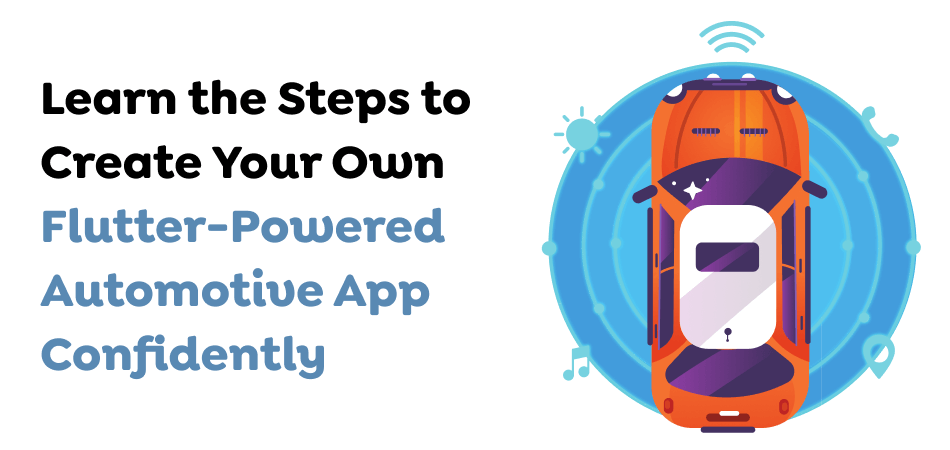
Begin by becoming familiar with the competition in the automotive sector, like BMW and Toyota, and note down any distinctive features or applications. Note down their latest apps and observe their most prominent features or functions.
My BMW offers its users intelligent e-mobility services with extensive navigation features and maps that help plan trips. At the same time, Toyota provides its customers with remote start/stop/lock/unlock capability as well as find-my-parked-vehicle functionality within its app.
Reviewing existing apps and their functionality can help you with the next step. However, keep track of your potential users! Create buyer personas to ensure you can determine potential user requirements and create user-friendly software applications.
Also Read : A Guide to Let You Build Your Advanced Mobile AI App
When developing something like BMW without duplicating particular features, it’s time to pick features that satisfy business objectives and user needs.
Creating buyer personas makes sorting out features designed explicitly for customers much easier. You can then use these personas to guide feature selection and application design. The most important features can be identified, and the first version can be built out much faster. Consider details about the vehicle, such as booking services, test drive request forms, and service-related reminders, as valuable elements for anyone interested in automobiles.
If your App has an extensive list of features, the next step is to imagine how it looks and what the experience will look like. Wireframing and prototyping tools allow you to bring your idea into the real world. Wireframing involves drawing or creating digital mockups to show screen layouts, while prototyping will enable users to test your app before launch.
Wireframes enable you to create an application and test its interfaces by prototyping it, an ideal method for developing Flutter apps similar to Toyota. Prototypes are clickable app versions, allowing users to test their capabilities. Still, there is no backing-end database development and connection so it won’t function like a similar app.
Prototyping is still helpful for testing and improving designs early, helping avoid costly errors. User feedback can also be collected to ensure a pleasant user experience. Professional designers can help create engaging prototypes or attractive designs to aid in this process.
After completing your design, prepare to engage Flutter application developers to start development. Once your design is finished and on its way to being developed, hire Flutter developers to begin creating. Our guide will provide some general guidelines for hiring Flutter developers; generally speaking, you should search for a hybrid app development company with a solid understanding of Flutter itself and the automotive industry and experience working on automotive designs using it.
Whether you use a freelance developer or a dedicated one, collaboration among everyone involved is essential to bringing your idea to life. Communicate clearly and provide regular updates throughout the process.
After your app is developed, testing, enhancement, and revering must begin immediately. Minor bugs can cause user problems, so errors or issues must be identified immediately and corrected. Flutter supports cross-platform app development, so ensure your app runs smoothly across various gadgets and operating systems.
Incorporate authentic users into the testing process by giving a test version a test run and capturing their feedback. Use this feedback to progress and refine your application until all elements work seamlessly.
Also Read : Which AR/VR Testing Tools Should You Use For Your AR/VR App?
It is now the right time to promote your application and usefulness to the world by increasing its profile with targeted markets and implementing strategic marketing strategies that stimulate curiosity. Engage customers using forums, social media, partnerships with dealers, or events to help spread the word about your app and collect user feedback. Then, you can add features that please them while ensuring they are engaged with the app.
It’s your turn! Design and estimate the costs associated with creating your Flutter application, similar to what BMW and Toyota are doing, all the while taking steps towards achieving the potential of Flutter for your business in the automotive sector.
Also Read : How to Determine Flutter App Development Cost?
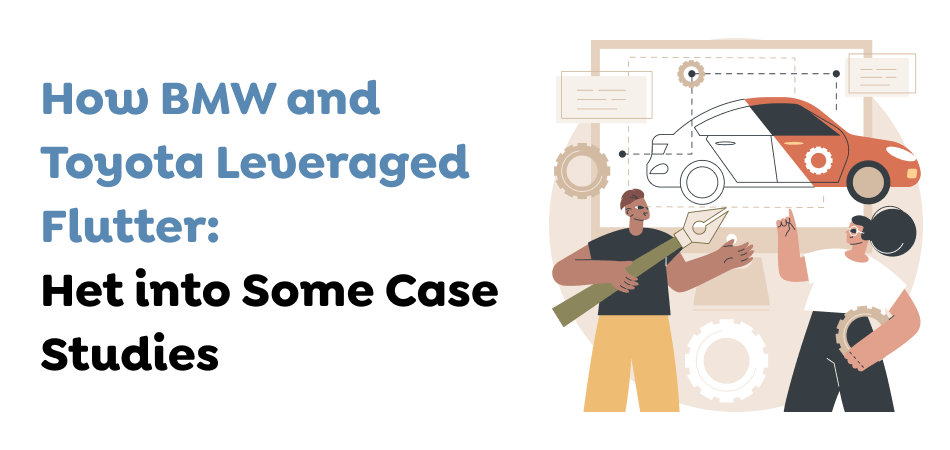
The BMW and MINI-connected apps available for iOS were the primary goal of BMW’s automotive App Development team for an extensive period. In 2018, however, they concluded that the gap between iOS and Android versions of their applications had grown considerably. They now need a solution that ensures the app is identical across every platform, including BMW and MINI.
From a business perspective from a commercial standpoint, they required a system that could allow them to continuously release updates to their application across all platforms and regions with the same options and features. The team was not sure Flutter would grow to the point that it could expand to the point at which BMW required it to function to ensure that they created reliable designs with different frameworks. Ironically, no framework other than Flutter delivered the expected results, a key factor in choosing Flutter.
They met with an engineering team to discuss how to proceed with Flutter in October this year. The company finally launched its My BMW app in July 2020, following less than one year in development. In over 47 countries and five continents, the application has become a standard connecting point for cars, mobile devices, and the Internet. BMW customers can now confidently access the App regardless of what device they pick.
Toyota faced the challenge of meeting consumers’ requirements for its infotainment system’s performance while ensuring it was fully integrated into driving experiences. It required a robust design that could support embedded devices while seeking to enhance the technology in its vehicles.
Toyota decided to explore Flutter app development services when they learned that Flutter could allow embedded devices to be used. The recognition that Flutter has for a high-performance rendering engine and its capabilities, such as hot-reload, AOT compilation, and embedder API, attracted the attention of Toyota—the capabilities aligned with Toyota’s goal of providing customers with an exceptional information and entertainment experience.
Utilizing Flutter’s SDK led to various positive results for Toyota’s development. Toyota was able to use Flutter’s internal tools to improve its overall productivity in development. Additionally, Flutter allowed Toyota to create design tools that produced code that allowed software execution and validation without requiring complex intermediate levels.
From automobiles to laptops, web browsers, desktops, smartphones, and smart home devices, Flutter is a highly reliable and trusted UI toolkit with an advanced SDK ready to take your car business wherever you’re needed to satisfy your customers’ expectations and needs.

Flutter offers enticing rapid user experiences, an efficient development environment, and the ability to create beautiful applications for the automotive industry. Since this development framework is unique, we as a cross-platform app development company highly recommend it for the next car project.
Embarking on automotive app development with Flutter can be a rewarding journey, but it requires the right partner to ensure success. Techugo offers a comprehensive range of services to help you bring your vision to life. Our team of experienced developers and designers specializes in creating innovative and user-friendly automotive apps that leverage the power of Flutter.
From concept development to deployment and ongoing support, Techugo provides end-to-end solutions tailored to your specific requirements. We leverage the latest technologies and industry best practices to ensure your automotive app is scalable, reliable and delivers exceptional performance.
Have more doubts yet? Get in touch with our experts!
Write Us
sales@techugo.comOr fill this form